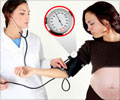- Women suffering from preeclampsia during pregnancy are more likely than women with normal blood pressure to develop hypertension after pregnancy
- Preeclampsia is a condition that occurs in pregnant women marked by high blood pressure and elevated protein in urine, affecting up to 5 percent of pregnancies in developed countries
Studying the Effect of Preeclampsia on Blood Pressure Values Post-pregnancy
- The study team followed up 200 women diagnosed with severe preeclampsia during their pregnancies.
- Severe preeclampsia refers to systolic blood pressure of 160 mmHg or more and/or diastolic blood pressure of 110 mmHg or greater.
- The women were monitored for one year after their pregnancies, which included measuring blood pressure during the day and night out of clinic as well as and taking blood pressure readings in the clinic.
- More than 41 percent of the women showed elevated blood pressure in the year after pregnancy.
- Interestingly, most of the women (17.5 percent) showed masked hypertension, that is, normal blood pressure readings in the doctor's office, but elevated readings outside of the doctor’s office when measured at different times during the course of the day
- Sustained hypertension was noted in 14.5 percent of the women; white coat hypertension (9.5 percent), when people have higher blood pressure readings at the doctor's clinic compared to outside the clinic setting (due to anxiety).
- Forty-six percent of the women showed insufficient decrease in blood pressure from day time readings and night readings which is considered unhealthy.
- Approximately 42.5 percent of women had night-time hypertension, which is associated with increased risk of heart disease, stroke and death
"Our findings suggest women who have high blood pressure during pregnancy should continue to monitor their blood pressure long after they've delivered their babies. It's not only important to monitor blood pressure in the doctor's office, but also at different times of the day and night, at home," Benschop said. "We've shown here that high blood pressure comes in many forms after pregnancy. Women who know their numbers can take the proper steps to lower their blood pressure and avoid the health consequences of high blood pressure later in life."
Possible Limitations of the Study
The study mainly included highly educated Caucasian women and thus the findings may not be reflective of all races, or income levels.Revised Guidelines for Diagnosing Hypertension
According to recently released guidelines by the American College of Cardiology/American Heart Association Task Force on Clinical Practice Guidelines, high blood pressure is now defined as systolic readings of 130 mm Hg and higher, or diastolic blood pressure readings of 80 or more. This is a significant change from the older values of 140/90 mmHg and higher, indicating that complications can occur at these lower readings as well.Preeclampsia In Brief
Preeclampsia (earlier referred to as toxemia of pregnancy) is a condition that usually occurs after 20 weeks of pregnancy in a woman who has been previously normal. It is marked by elevated blood pressure and excretion of increased amounts of protein in the urine. It can be asymptomatic and if it goes undetected, can result in serious sometimes fatal complications for both the mother as well as the baby.References:
- Pre-eclampsia - (https://www.nhs.uk/conditions/pre-eclampsia/)
















